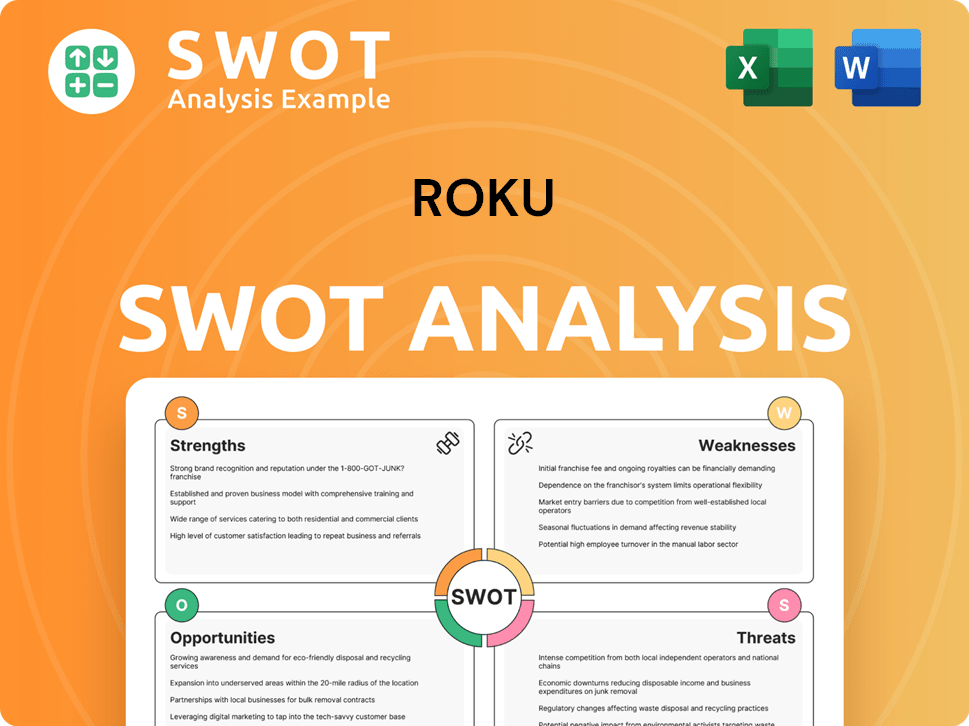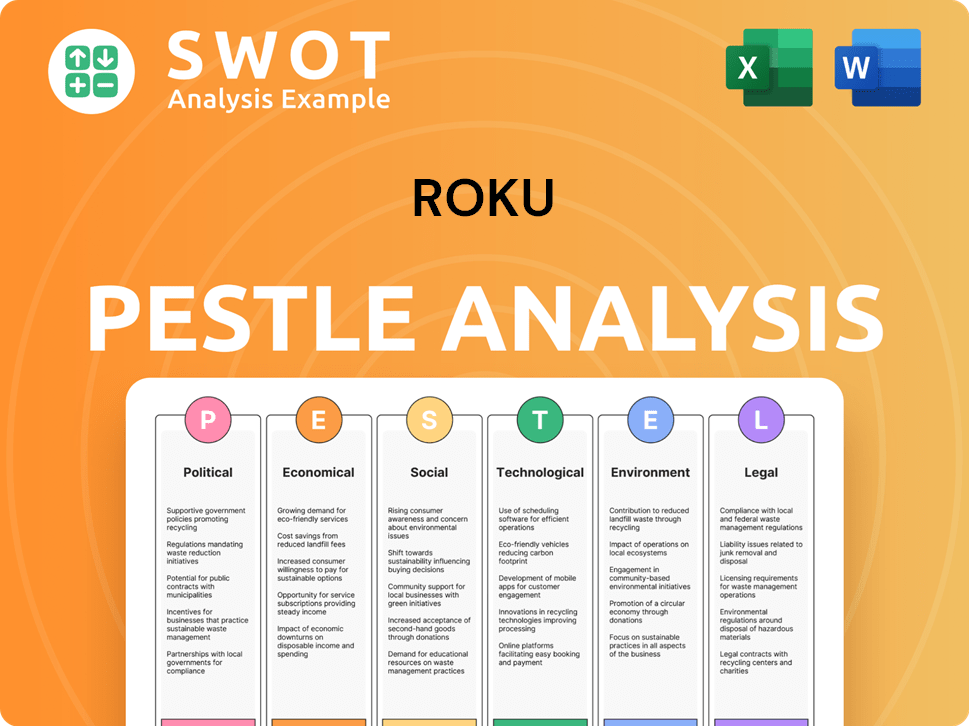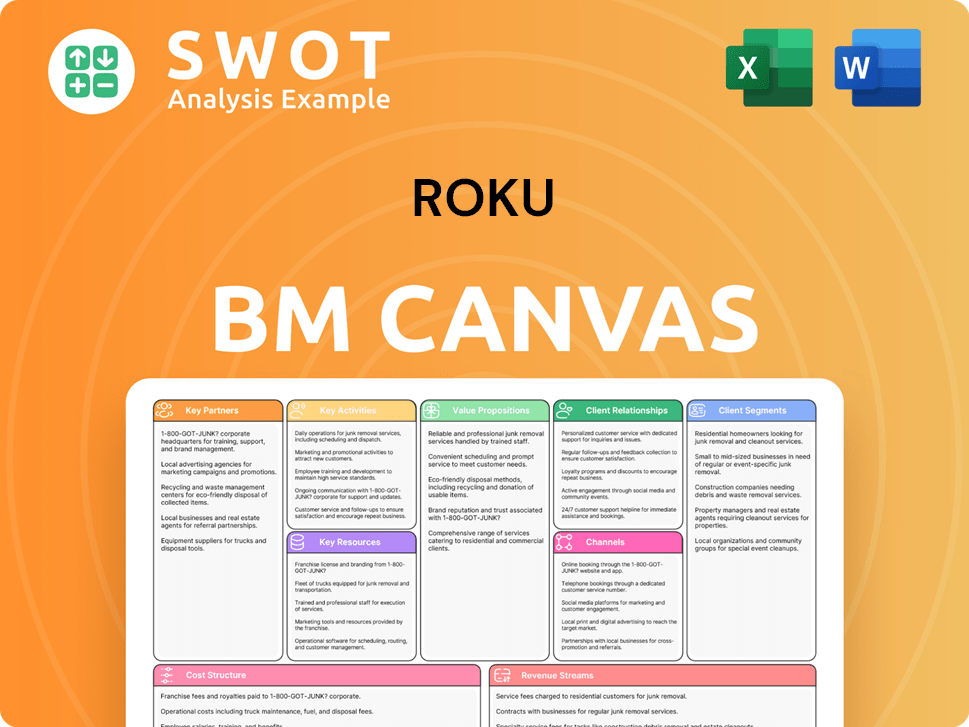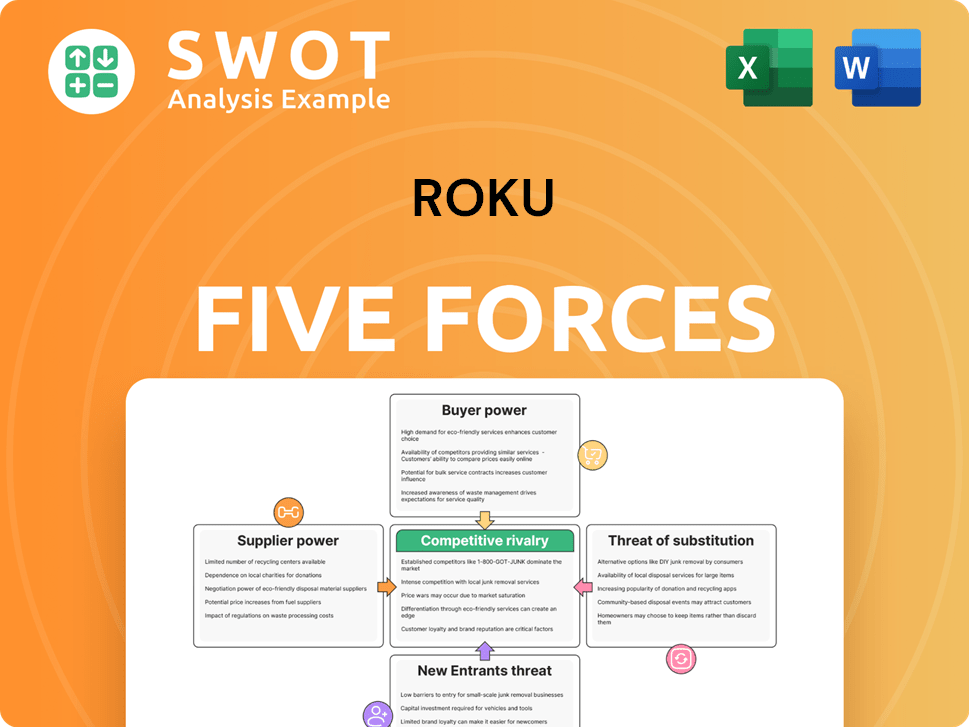Roku Bundle
Who Watches Roku? Unveiling the Demographics Behind the Streaming Giant
In the ever-evolving world of streaming, understanding the "who" behind the "what" is crucial. Roku's success hinges on its ability to attract and retain a diverse audience, making a deep dive into its Roku SWOT Analysis and customer base essential. From cord-cutters to tech enthusiasts, the Roku platform caters to a wide array of users. This exploration reveals the key demographics and psychographics driving Roku's market dominance.

This analysis of Roku customer demographics and Roku target market aims to provide a comprehensive understanding of Roku users. We'll delve into Roku streaming service demographics, including age, income, location, and interests, to paint a detailed picture of the Roku audience. This insight is vital for anyone looking to understand the competitive landscape and the future of streaming.
Who Are Roku’s Main Customers?
The primary customer segments for the company are primarily consumers (B2C) seeking accessible and user-friendly access to a wide variety of streaming content. The core demographics encompass a broad age range, with a notable concentration among households that have either cut the cord entirely or are looking to supplement their traditional TV services. This focus is evident in their strategy of offering devices at various price points, appealing to a diverse income spectrum.
Historically, the initial target audience might have leaned towards tech-savvy individuals and early adopters of streaming technology. However, with the widespread adoption of streaming, the customer base has expanded to include a significant number of general consumers who prioritize ease of use and content variety. Their focus on a simple interface and comprehensive content aggregation has made it appealing to families and individuals across various demographics. The growth in active accounts and platform revenue indicates a successful expansion beyond its initial niche, with the mass market of streaming consumers now representing the largest share of its growth.
The company has broadened its reach by licensing its operating system to smart TV manufacturers, further expanding its presence in the mass market. This strategic move allows the company to tap into a wider audience, including those who may not have initially considered purchasing a separate streaming device. This approach has contributed to its increasing market share and user base, solidifying its position in the competitive streaming landscape. The company's success is also reflected in its financial performance, with platform revenue showing consistent growth.
The company's customer base includes a wide age range, with a significant portion of users being cord-cutters or those supplementing traditional TV services. The company's devices cater to diverse income levels through varied price points. The company's user base has expanded beyond tech-savvy early adopters to include general consumers.
The company's expansion includes licensing its operating system to smart TV manufacturers. This strategy broadens its reach to a mass market. The focus on ease of use and content aggregation appeals to families and individuals across various demographics.
The company's growth in active accounts and platform revenue indicates successful expansion. The mass market of streaming consumers now represents the largest share of its growth. The company's simple interface and content offerings attract a broad audience.
The company's user base includes a mix of cord-cutters, cord-nevers, and those supplementing traditional TV. The company's devices are designed to appeal to a wide range of users. The company's focus on ease of use and content variety is a key factor in its broad appeal.
The company's customer base is diverse, with a significant portion of users being cord-cutters or those supplementing traditional TV services. The company's devices cater to diverse income levels through varied price points. The company's user base has expanded beyond tech-savvy early adopters to include general consumers.
- Roku customer demographics include a wide age range, with a concentration among those cutting the cord or supplementing traditional TV.
- Roku target market has expanded to include general consumers who value ease of use and content variety.
- The company's strategy of offering devices at various price points appeals to a diverse income spectrum, broadening its Roku audience.
- Licensing its operating system to smart TV manufacturers has further expanded its reach to a mass market, increasing Roku users.
Roku SWOT Analysis
- Complete SWOT Breakdown
- Fully Customizable
- Editable in Excel & Word
- Professional Formatting
- Investor-Ready Format

What Do Roku’s Customers Want?
Understanding the needs and preferences of the Roku customer demographics is crucial for the company's success. These customers are primarily drawn to accessible and affordable entertainment options, seeking alternatives to traditional cable subscriptions. The Roku target market is broad, encompassing individuals and households looking for diverse content and a user-friendly streaming experience.
Roku users often prioritize ease of use, cost-effectiveness, and the availability of their favorite streaming services. Their purchasing decisions are heavily influenced by the price of the device, the simplicity of setup, and the ability to access a wide array of content. The platform's ability to aggregate various streaming services into a single interface is a significant draw for many.
The psychological drivers for choosing Roku streaming offerings include a desire for control over viewing habits and the freedom from rigid programming schedules. Practical considerations such as cost savings compared to traditional cable and the convenience of a single platform for multiple streaming services are also key factors. By understanding these preferences, Roku can tailor its product development and marketing strategies to meet its customers' needs effectively.
Roku's audience values simplicity, affordability, and content variety. They seek to reduce or eliminate cable expenses and enjoy the convenience of on-demand entertainment. The platform addresses pain points related to complex smart TV interfaces and content fragmentation, offering a unified and intuitive experience. For a deeper dive into Roku's business model, consider reading about the Revenue Streams & Business Model of Roku.
- Cost Savings: Customers are motivated by the potential to save money compared to traditional cable subscriptions.
- Content Variety: Access to a wide range of streaming services and free ad-supported content is a major draw.
- Ease of Use: The user-friendly interface and simple setup process are highly valued.
- Convenience: The ability to access multiple streaming services from a single platform is a key benefit.
Roku PESTLE Analysis
- Covers All 6 PESTLE Categories
- No Research Needed – Save Hours of Work
- Built by Experts, Trusted by Consultants
- Instant Download, Ready to Use
- 100% Editable, Fully Customizable

Where does Roku operate?
The geographical market presence of the company is primarily centered in North America. The United States and Canada are the core markets, where the company has established a strong brand presence and significant market share. This concentration reflects the maturity of the streaming market in these regions and the company's strategic focus.
In the U.S., the company has a substantial foothold in the connected TV device market. The company's market share in the United States for streaming media players was 45% in Q4 2023. While the company has made efforts to expand internationally, North America remains its most significant market in terms of both sales and user base.
Expansion outside North America involves adapting to diverse customer demographics and preferences. Localization strategies are crucial, as content preferences, language support, and payment methods vary significantly across different regions. The company tailors its offerings by adjusting content partnerships, user interfaces, and marketing campaigns to suit specific regional tastes and regulatory environments. For more insights into the company's overall growth strategy, you can explore the Growth Strategy of Roku.
The company held approximately 40% of the connected TV device market in the United States in 2023. This demonstrates its strong position in the domestic market. This market share highlights the company's dominance in the streaming device sector.
While North America is the primary focus, the company continues measured international development. The company's growth in active accounts suggests ongoing expansion, although the geographic distribution of sales remains heavily weighted towards North America. The company adapts its offerings to suit regional tastes and regulatory environments.
Roku Business Model Canvas
- Complete 9-Block Business Model Canvas
- Effortlessly Communicate Your Business Strategy
- Investor-Ready BMC Format
- 100% Editable and Customizable
- Clear and Structured Layout

How Does Roku Win & Keep Customers?
The company employs a multifaceted approach to customer acquisition and retention, leveraging both its hardware and platform offerings. Its strategy includes digital advertising, traditional media, and strategic partnerships with content providers and TV manufacturers. The affordability and ease of use of the streaming devices are key acquisition tools.
Sales tactics like promotional pricing for devices and bundles with content subscriptions also attract new customers. For retention, the company focuses on enhancing the user experience through continuous platform updates, new content additions, and personalized recommendations. The value proposition of a vast and growing library of free ad-supported content, alongside access to premium subscription services, plays a significant role in keeping users engaged.
Customer data and segmentation are crucial for targeting marketing campaigns and personalizing content discovery. Data on user viewing habits helps offer tailored content suggestions and advertising, improving engagement and loyalty. Changes in strategy over time have included a greater emphasis on platform revenue, particularly advertising, which has contributed to increased customer lifetime value and reduced reliance on hardware sales for profitability. Read more about the Owners & Shareholders of Roku.
The company uses a combination of digital advertising, traditional media, and partnerships to attract new customers. The low cost and ease of use of streaming devices are primary acquisition tools. Promotional pricing and content bundles also help to bring in new users to the platform.
Retention efforts center on improving user experience through platform updates, new content, and personalized recommendations. A large library of free, ad-supported content and access to premium subscriptions keep users engaged. Customer data analysis is used to tailor content suggestions and advertising.
The company’s success is evident in its growing user base and revenue. The focus on platform revenue, particularly advertising, has increased customer lifetime value. The company's active accounts globally reached 81.6 million in Q4 2023, a 16% year-over-year increase.
- Roku customer demographics are diverse, spanning various age groups, income levels, and locations, unified by their interest in streaming.
- The Roku target market includes cord-cutters, cord-nevers, and those seeking affordable and accessible entertainment options.
- Roku users are attracted by the convenience of accessing multiple streaming services through a single device.
- Roku streaming continues to evolve, with the company constantly adding new content and features to enhance user engagement.
Roku Porter's Five Forces Analysis
- Covers All 5 Competitive Forces in Detail
- Structured for Consultants, Students, and Founders
- 100% Editable in Microsoft Word & Excel
- Instant Digital Download – Use Immediately
- Compatible with Mac & PC – Fully Unlocked

Related Blogs
- What are Mission Vision & Core Values of Roku Company?
- What is Competitive Landscape of Roku Company?
- What is Growth Strategy and Future Prospects of Roku Company?
- How Does Roku Company Work?
- What is Sales and Marketing Strategy of Roku Company?
- What is Brief History of Roku Company?
- Who Owns Roku Company?
Disclaimer
All information, articles, and product details provided on this website are for general informational and educational purposes only. We do not claim any ownership over, nor do we intend to infringe upon, any trademarks, copyrights, logos, brand names, or other intellectual property mentioned or depicted on this site. Such intellectual property remains the property of its respective owners, and any references here are made solely for identification or informational purposes, without implying any affiliation, endorsement, or partnership.
We make no representations or warranties, express or implied, regarding the accuracy, completeness, or suitability of any content or products presented. Nothing on this website should be construed as legal, tax, investment, financial, medical, or other professional advice. In addition, no part of this site—including articles or product references—constitutes a solicitation, recommendation, endorsement, advertisement, or offer to buy or sell any securities, franchises, or other financial instruments, particularly in jurisdictions where such activity would be unlawful.
All content is of a general nature and may not address the specific circumstances of any individual or entity. It is not a substitute for professional advice or services. Any actions you take based on the information provided here are strictly at your own risk. You accept full responsibility for any decisions or outcomes arising from your use of this website and agree to release us from any liability in connection with your use of, or reliance upon, the content or products found herein.